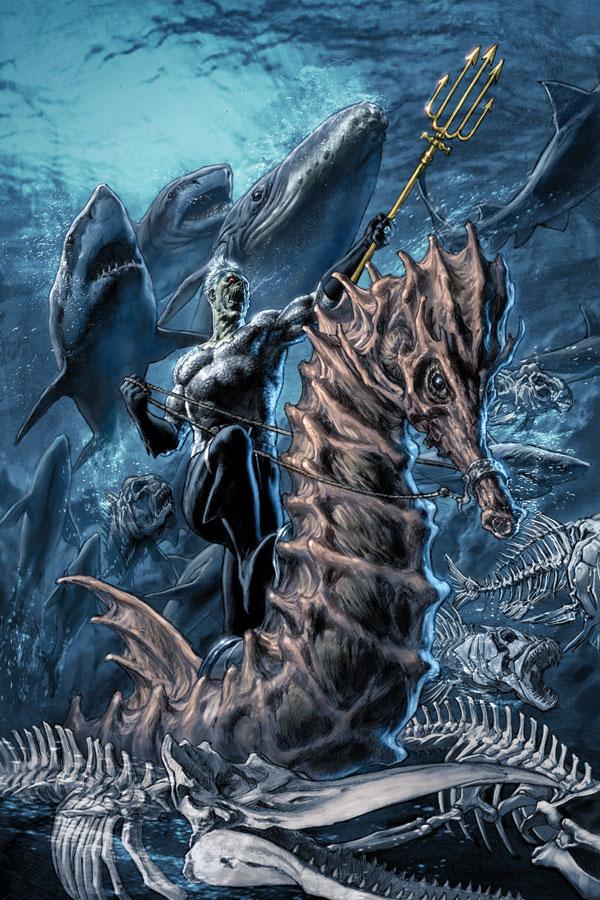Philippe, you're right to point out that superhero deaths are (mostly) meaningless, and I'd say this is even more problematic in the DC Universe than the Marvel Universe. Why? Well, to begin, DC pioneered the "kill him off/bring him back" marketing campaign with the DEATH OF SUPERMAN back in 1992. So we can blame them for that. But that's not really what I'm getting at here.
 |
| "It will be Batman's turn in 20 years" |
Those fears turned out to be well-founded when, in 2009, DC brought all the dead back as killer zombie Black Lanterns in the hugely disappointing BLACKEST NIGHT. This the the moment when the wheels fell of that iteration of the DCU.
 |
What, exactly does zombie Aquaman
expect the humpback whale to do?!
|
But...
If I lament the death of DC's old continuity,* it's because, for a while, it gave us really compelling stories--including crossovers. True, they weren't all good--INFINITE CRISIS was, at best, so-so, COUNTDOWN was abominable, and FINAL CRISIS was near unreadable. But we also got three crossovers that were fantastic: IDENTITY CRISIS, 52 and the SINESTRO CORPS WAR.
The same is arguably true for Marvel. AVENGERS DISASSEMBLED is good. HOUSE OF M is really, really good. CIVIL WAR would have been good, had Mark Millar not gotten sick and had Marvel given him the 4 issues he needed to finish the story, rather than the 2 he got.
So...What Makes a "Good" Crossover?
All haterade aside, I'm going to suggest that good crossovers are possible, that they do happen, and that we can actually identify a winning formula.
For the sake of argument, let's take a look a bunch of major crossovers published over the past decade. To begin, I'll create a "good" label for IDENTITY CRISIS, 52, SINESTRO CORPS WAR, AVENGERS DISASSEMBLED, HOUSE OF M and CIVIL WAR; and a "bad" label for INFINITE CRISIS, COUNTDOWN, FINAL CRISIS, BLACKEST NIGHT, WORLD WAR HULK and SECRET INVASION. That gives us 6 cases in each category. When you look at what made the good ones good, and the bad ones bad, a pattern starts to emerge:
- 4/6 "good" crossovers focus only on a limited set of characters, whereas 4/6 "bad" crossovers are sprawling, universe-wide affairs
- Only 2/6 "good" crossovers feature reality-menacing, evil supervillains, compared with 4/6 "bad" crossovers
- In 5/6 "good" crossovers, you understand and sympathize with the eventual loser, whereas that's only true of 1/6 "bad" crossovers
- 5/6 "good" crossovers center on the personal relationships and histories of the superheroes, compared with 3/6 "bad" crossovers
Taken together, we can conclude that the "ultimate" crossover is one that tightly focuses on a limited set of characters, eschews evil supervillains in favor of sympathetic and/or tragic figures, and centers drama on personal relationships rather than epic battles.
Incidentally, that description best fits IDENTITY CRISIS and HOUSE OF M, which I consider to be the most successful crossover events of the 12 mentioned above. Both have thrilling, well-paced plots, to be sure, but they play second fiddle to exploration of what makes these heroes truly human: their flaws, weaknesses, dreams and fears. They are about relationships, and about the deep stress all these heroes must be under. Neither features a villain, per se, but a tragic figure whose motivations are largely understandable. I go back to these two stories at least once a year, and think they are about as good as superhero writing gets.
 |
| Wanda struggles to hold it together |
Plus then there's this: all but one of the "good" crossovers I mentioned above was published during the years 2004-2006. The bad ones generally come after that. What does that tell us? My guess would be that this wave of crossovers began with some creative people over at DC and Marvel pitching cool ideas for, you know, stories. But when these things blew up, the marketing folks probably decided it had to become an annual thing--something to get attention and improve the bottom line. Given the drop in comics readership over the past decade, I can sympathize, but if true, it was a short-term strategy that may have ultimately done more harm than good. It seems to me as if both readers and writers have crossover fatigue at the moment. Thankfully, we've got a break this summer. Sort of.
*Technically the pre-NEW 52 continuity only goes back to INFINITE CRISIS, but the reverberations of pre-crisis events were still felt post-crisis, so it makes sense to stretch it back further.